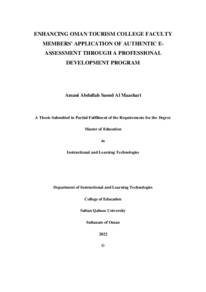Document
Enhancing Oman Tourism College faculty members' application of authentic E-assessment through a professional development programme.
Other titles
تعزيز استخدام التقييم الإلكتروني الواقعي لدى محاضري كلية عمان للسياحة من خلال برنامج التطوير المهني
Publisher
Sultan Qaboos University.
Gregorian
2022
Language
English
English abstract
Due to the Covid-19 pandemic, higher education institutions around the globe had
to shift to online teaching and learning. This also included an assessment of which various
types were conducted online. Despite the fact that a wide range of new tools and
opportunities for developing effective authentic assessments is provided by technology,
the current e-assessment design at Oman Tourism College does not seem to adequately
achieve the required pedagogical objectives in an e-learning environment. Consequently,
professional development was believed to bridge this gap and enable the teaching staff at
Oman Tourism College to redesign their e-assessment by developing effective e assessment methods and procedures that are more appropriate for their teaching context
which has become totally online.
The aim of this study is to explore the teachers' views on the process of redesigning
and implementing authentic e-assessment. It describes the design concepts that academic
staff have utilized to re-design their e-assessments to support their students' learning. The
study adopted a qualitative methodological approach where a Professional Development
Program (PDP) was delivered virtually to help 8 faculty members better improve and
increase their competencies in the selection, adaptation, and design of authentic e assessment tasks. The data collection was mainly based on a training program where the
participants provided their opinions and feedback on the program content through a set of
pre-determined reflection questions and semi-structured interviews.
The findings showed that teachers were able to gain various new e-assessment
skills and techniques and apply them within their own assessment practice. The findings
also revealed the existence of several challenges and concerns associated with the design
and implementation of e-assessment most of which are related to the teaching context such
as lack of time, resources, and adequate technology. Furthermore, teachers identified
several aspects through which the authenticity of e- assessment could be increased, such
as embedding assessment techniques in the teaching materials, reflecting on real-life
situations, and introducing more authentic assessment tasks within the overall assessment
process. Finally, teachers identified some aspects in which they would be able to reshape
their future e- assessment practice based on what they learned from the training program.
This included, for example, giving more focused feedback, designing portfolios, and
delivering e-assessment in a more logical and structured manner. The study concludes
with recommendations and implications for better future practice in terms of authentic
design and implementation of e-assessment.
Member of
Resource URL
Arabic abstract
بسبب جائحة كوفيد -19توجهت العديد من المؤسسات التعليمية حول العالم إلى استخدام التقييم الإلكتروني كبديل لأسلوب التقييم التقليدي لتقييم أداء الطالب. وبالرغم من أن التقدم التكنولوجي قدم الكثير من الأدوات والفرص للتقييم الإلكتروني الأ أن التقييم الإلكتروني في كلية عمان للسياحة ال يتماشى مع الأهداف التربوية لبيئات التعليم الإلكتروني. ومن هذا المنطلق، هدفت الدراسة إلى تعزيز استخدام التقييم الإلكتروني من خلال برنامح التوطير المهني و الذي قد يسهم في منح أعضاء هيئة التدريس فرصة إلعادة تصميم وسائل التقييم الإلكترونية وتطوير الأستراتيجيات المتعلقة و ّظ الأكاديميون إلعادة تصميم بذلك ك ل حسب تخصصه .وتسلط هذه الدراسة الضوء على مفاهيم التصميم التي فها التقييم الإلكتروني لدعم العملية التعليمية .اعتمدت الدراسة الأسلوب المنهجي النوعي الذي يتم من خلاله تقديم ورش وإجراء مقابالت افتراضية وحضورية لتقديم الدعم الالزم لثمانية عضًوا أكاديميًا لتطوير كفاءاتهم في اختيار ومواءمة وتصميم التقييم الإلكتروني . أظهرت نتائج الدراسة أن أعضاء هيئة التدريس كانوا قادرين على اكتساب مهارات وتقنيات جديدة مختلفة في التقييم الإلكتروني وتطبيقها في ممارسات التقييم الخاصة بهم. كذلك أظهرت النتائج وجود العديد من التحديات والمخاوف المرتبطة بتصميم وتنفيذ التقييم الإلكتروني، والتي يرتبط معظمها بالسياق التعليمي مثل ضيق الوقت ونقص الموارد والتكنولوجيا المناسبة. بالأضافة الى ذلك، حدد المشاركون في البرنامج جوانب عديدة يمكن من خلالها زيادة موثوقية ومصداقية التقييم الإلكتروني مثل تضمين تقنيات التقييم في محتوى المواد الدراسية، عكس مواقف الحياة الواقعية، وإدخال طرق تقييم أكثر واقعية في عملية التقييم الشاملة. أخيرا، حدد المشاركون بعض الجوانب التي يمكنهم من خلالها إعادة تشكيل ممارسات التقييم الإلكتروني المستقبلية بنا ًء على ما اكتسبوه من خلال برنامج التدريب وشمل ذلك، على سبيل المثال، تقديم تغذية راجعة أكثر تركيزا، تصميم المحافظ، واجراء التقييم الإلكتروني من خلال طرق أكثر منطقية وتنظيما. وتختم الدراسة بإعطاء توصيات من أجل ممارسة مستقبلية أفضل فيما يخص تصميم وتنفيذ حقيقي وموثوق للتتقييم الإلكتروني.
Category
Theses and Dissertations

